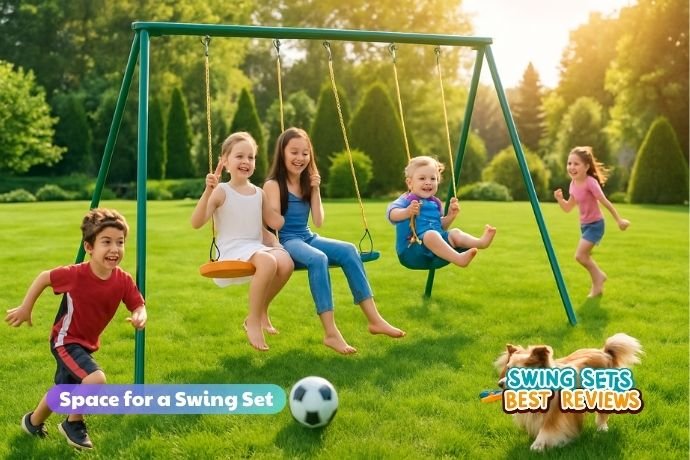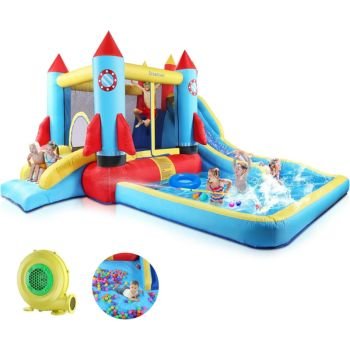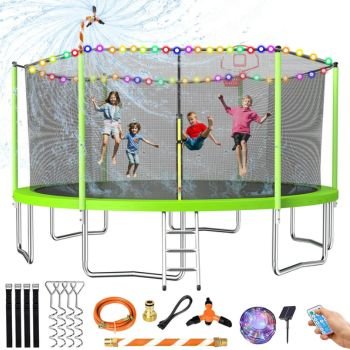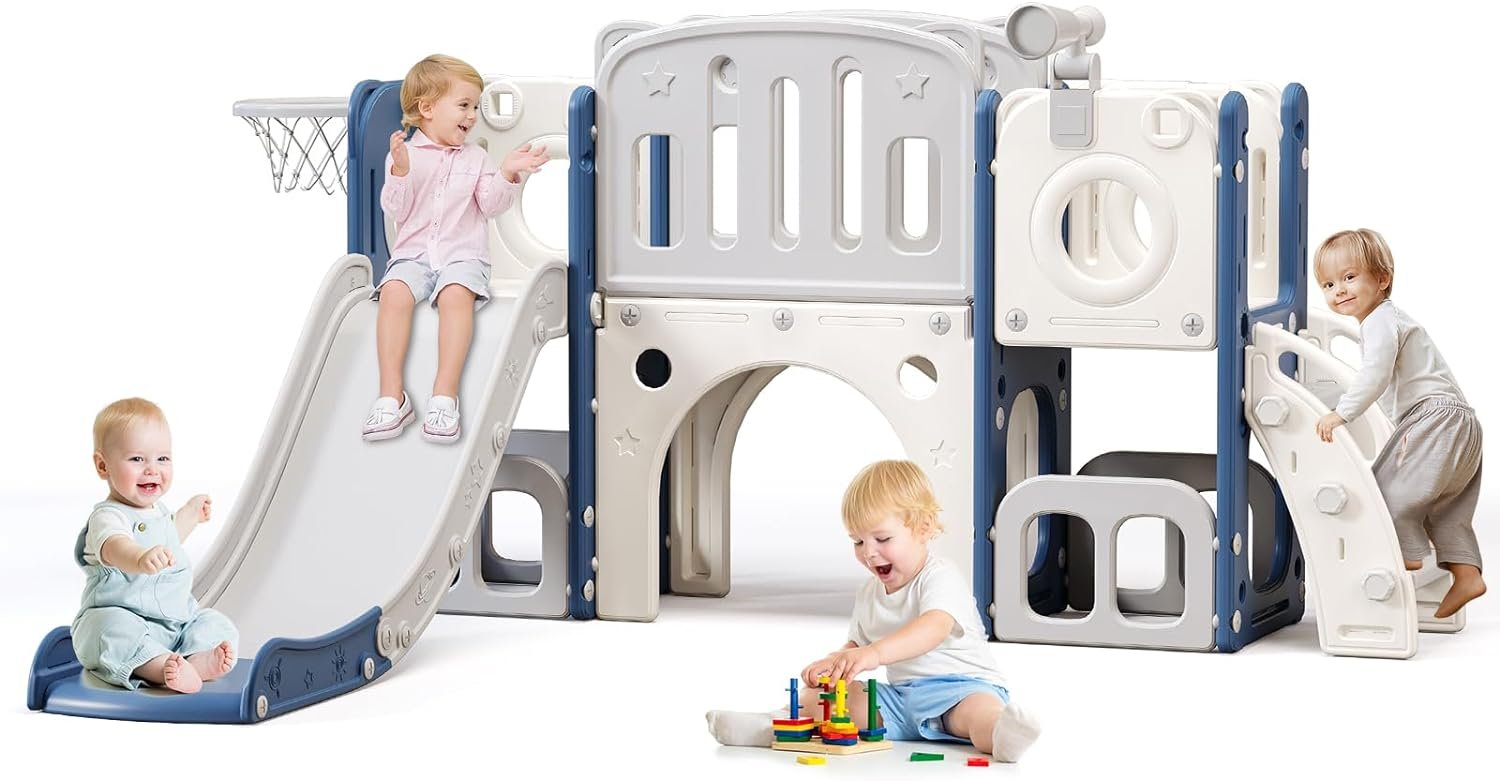If you’ve ever dreamed of transforming your backyard into the ultimate playground, a swing set is probably at the top of your wish list. But before you buy one and set it up, the first question you need to answer is simple yet crucial: how much space do you need for a swing set? This isn’t just about squeezing it into your yard—it’s about ensuring your kids have plenty of room to play safely while still leaving space for the rest of your outdoor activities.
Most parents get excited about picking the design, the slides, or even the number of swings, but the most overlooked part is the space planning. Without enough clearance around the set, you risk accidents, damaged fences, and a less enjoyable play experience. Just like you wouldn’t buy furniture without checking if it fits in your living room, a swing set requires the same careful thought.
In this article, we’ll dive deep into the exact space requirements for different types of swing sets, safety standards you should follow, and tips on how to prepare your backyard. By the end, you’ll have a clear blueprint for making the most out of your yard while giving your children a safe and fun place to play.
Understanding the Basics of Swing Set Space Requirements
Before we get into the nitty-gritty, let’s cover the fundamentals. Every swing set, no matter the size, needs more space than its actual footprint. That’s because kids don’t just sit still—they swing, climb, jump, and slide. Each of these actions requires a safe clearance zone to prevent accidents.
The golden rule for swing sets is that you need at least 6 feet of clearance on all sides of the structure. For example, if your swing set is 10 feet wide, you’ll want at least 22 feet of width in your yard (10 feet for the set itself + 6 feet clearance on each side). The same goes for the front and back—especially important because swings move in big arcs that need extra room.
Another critical aspect is overhead clearance. A swing set might be 7 or 8 feet tall, but if you place it under a tree branch or near a roof overhang, kids could hit their heads. Always ensure that the play area is free from low-hanging obstacles.
Standard Swing Set Sizes
Swing sets come in different sizes, and naturally, their space requirements vary.
- Small Swing Sets (6–8 feet wide): These are perfect for toddlers or compact yards. Even though they’re small, they still require at least 6 feet of clearance around them, meaning a set that’s 6 feet wide will need about 18 feet of total width in your yard.
- Medium Swing Sets (8–12 feet wide): The most common size for families, these sets usually feature 2–3 swings and sometimes a slide. Expect to need around 24–28 feet of total space.
- Large Swing Sets (12+ feet wide): These are the deluxe models with multiple swings, slides, climbing walls, and sometimes even playhouses. A set that’s 14 feet wide could easily require 30–32 feet of width to be safe.
Remember, these are just the widths. The length of the set, plus the front and back clearance, also plays a huge role.
Safety Zones Around Swing Sets
Safety zones are non-negotiable. Kids love to run around swing sets, not just use them. A properly planned safety zone ensures they won’t collide with fences, walls, or even each other.
- Side Clearance: At least 6 feet on each side. This prevents kids from bumping into fences or hard surfaces.
- Front and Back Clearance: At least twice the height of the swing. So, if your swing is 8 feet high, you’ll want 16 feet of clearance both in front and back. This accounts for the full swing arc.
- Overhead Clearance: A minimum of 8–10 feet above the swing set, free from branches, wires, or awnings.
Think of the safety zone as an invisible bubble around the swing set—it’s there to keep play safe and free from obstacles.
✅ Related Articles
- How to Install a Swing Set: Step-by-Step Guide
- Discover the Ultimate Indoor Climbing Toys for Rainy Days
- DIY Playhouse Ideas for Budget-Friendly Parents
- The Truth About Swing and Slide Combo Playsets | Pros, Cons
Factors That Determine How Much Space You Need for a Swing Set
Not all yards are the same, and not all swing sets are built alike. That’s why the exact space you need for a swing set depends on several key factors.
First is the size and shape of your yard. A rectangular yard may fit a swing set differently than an oddly shaped or sloped yard. You’ll also need to account for things like patios, sheds, or gardens that already take up space.
Second, the number of swings and accessories you choose will increase the footprint. A basic two-swing model might need less than 20 feet of width, while one with monkey bars, slides, and a climbing wall could need twice that.
Third, consider the age of your children. Toddlers don’t need as much swinging arc as older kids, but as they grow, they’ll want bigger, faster swings. Planning for growth can save you from having to upgrade too soon.
Finally, the material and design of the swing set matter. Wooden sets often take up more room than slim metal ones, and modular sets with towers and bridges need more clearance.
The Shape and Slope of Your Yard
A flat, open yard is ideal, but not everyone has one. If your yard has a slope, you’ll either need to level the ground or choose a swing set designed for uneven terrain. Installing a swing set on a slope without adjustments can lead to instability and safety risks.
Oddly shaped yards can also complicate things. For example, a narrow yard might fit a swing set lengthwise but leave little clearance on the sides. In these cases, choosing a compact model or customizing your playset is the smarter choice.
Swing Set Material and Design Impact
The construction of the swing set makes a big difference in space requirements.
- Wooden Swing Sets: Sturdy, long-lasting, and often bulkier. They tend to have built-in extras like slides or climbing walls, so they need more space.
- Metal Swing Sets: Generally slimmer and more compact. A good choice for smaller yards, though they may offer fewer accessories.
- Modular or Custom Sets: These allow you to add features over time, but you’ll need to account for future space needs.
When planning, don’t just think about the swing set as it looks today. Imagine what it might look like as you expand or upgrade it over the years.
Recommended Space for Different Types of Swing Sets
Now that we’ve covered the basics and the factors, let’s look at some actual numbers for different types of swing sets. Not all families need a massive deluxe playset—sometimes a small, compact swing is more than enough.
The recommended space depends on the type of swing set you’re considering. Here’s a breakdown:
- Toddler Swing Sets: These small, usually portable sets are perfect for young children. They need about 12–16 feet of total space.
- Standard Backyard Swing Sets: The most common type, usually with 2–3 swings and maybe a slide. These need 24–28 feet of width and at least 20–24 feet of length.
- Deluxe Playsets: These feature multiple swings, slides, climbing walls, and playhouses. Expect to dedicate 30–40 feet in width and 25–30 feet in length for safe play.
Choosing the right size comes down to your yard’s dimensions, your kids’ ages, and how much you want to invest in backyard fun.
Small Swing Sets for Limited Yards
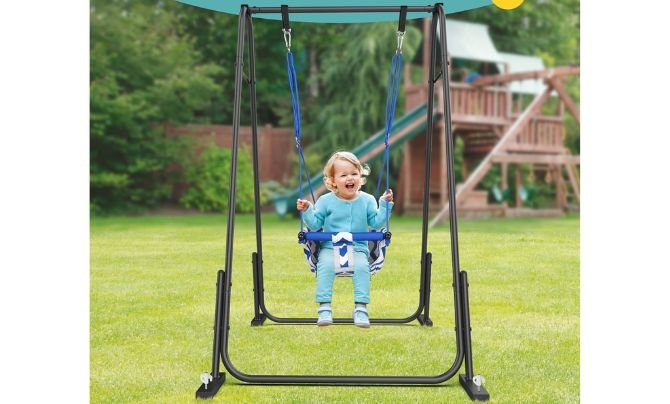
Not everyone has a sprawling backyard, and that’s okay. If you live in a city or have a smaller outdoor space, you can still give your kids a swing set—you just need to choose the right one. Compact or small swing sets are designed with limited yards in mind, making them a smart choice for families who want fun without crowding their entire outdoor area.
Small swing sets usually measure 6–8 feet wide and 5–7 feet tall. They often feature one or two swings and sometimes a toddler bucket seat. The good news? Even though the structure itself is small, you still need to leave safety clearance around it. Plan for at least 6 feet of space on all sides. This means a swing set that’s 7 feet wide should really have about 19 feet of usable width in your yard to fit comfortably and safely.
One of the biggest advantages of a small swing set is portability. Many lightweight sets, especially those made from metal, can be moved if you decide to re-arrange your yard or take them down for winter storage. They also cost less and are easier to assemble, making them a great starter option for families with toddlers.
Of course, small swing sets do come with some trade-offs. As kids grow, they’ll likely outgrow a compact set within a few years. That’s why many parents see them as a short-term investment or choose modular models that can expand later. Still, for limited yards, a small swing set offers the perfect balance of fun, safety, and space efficiency.
Large Multi-Feature Swing Sets
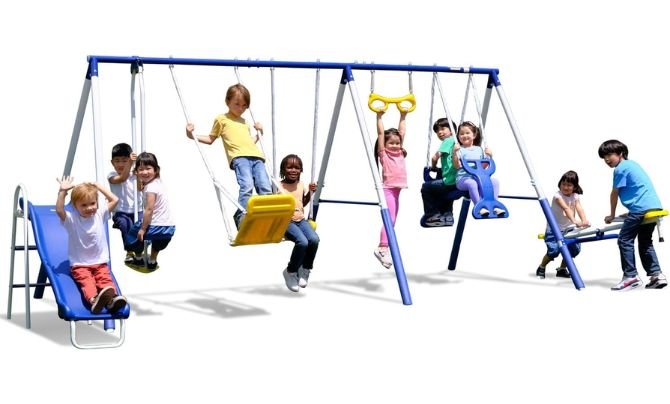
On the opposite end of the spectrum are the deluxe, multi-feature swing sets that turn a backyard into a mini amusement park. These are the ones with not just swings but also slides, climbing walls, rope ladders, monkey bars, and sometimes even playhouses or lookout towers.
These large swing sets often start at 12 feet wide and can stretch to 20 feet or more depending on the design. When you add in the safety clearance, you may need a yard that’s at least 40 feet wide and 30 feet deep to accommodate everything comfortably.
One of the best things about multi-feature swing sets is that they grow with your kids. A toddler may only use the bucket swing and a short slide at first, but as they get older, they’ll start climbing, swinging higher, and racing down long slides. Having all these features in one set means your kids won’t get bored easily.
But the size of these swing sets does pose challenges. First, they’re more expensive and require professional installation in most cases. Second, you’ll need a large, flat area of your yard to set them up properly. And third, you should always plan for extra safety clearance—a 14-foot slide might technically fit in a 20-foot space, but without room to run around it, kids could still get hurt.
If you have the space and budget, though, large swing sets are worth it. They turn your backyard into a destination where kids can spend hours without screen time, and they add long-term value to your property for future families as well.
Safety Considerations When Planning Space for a Swing Set
It doesn’t matter how much space you have—safety must always come first when installing a swing set. Every year, thousands of children are treated for playground-related injuries, many of which could have been prevented with proper planning and safe spacing.
The Consumer Product Safety Commission (CPSC) and ASTM International have published clear guidelines for backyard playgrounds, including swing sets. The main takeaway is that you should always leave a fall zone around every play feature. That means if a child falls off a swing, a slide, or a climbing wall, they should land on safe, cushioned ground—not concrete, dirt, or worse, a fence.
Another consideration is placement away from hazards. Avoid putting swing sets near driveways, pools, or garden tools. Even something as simple as a flower bed with sharp edging could become dangerous if a child trips near it.
Lastly, think about supervision. Place the swing set in a spot that’s easily visible from your house or patio. Parents should never have to lean out a window or walk to the far corner of the yard to check on their kids. The easier it is to supervise, the safer playtime will be.
Fall Zones and Surfacing Materials
The ground beneath your swing set is just as important as the set itself. Hard surfaces like concrete or packed dirt can cause serious injuries in a fall. That’s why experts recommend covering the play area with impact-absorbing materials.
Some of the best options include:
- Rubber mulch: Soft, durable, and low-maintenance.
- Wood mulch or engineered wood fiber: Affordable and effective, though it may need to be replenished.
- Rubber mats or tiles: Provide excellent cushioning and are easy to clean.
- Artificial turf with padding: Looks natural but still provides shock absorption.
The general rule is to cover the fall zone with at least 9–12 inches of protective surfacing. For a swing set, that means covering not just the footprint but the entire safety clearance area around it.
Clearance for Moving Swings
When kids swing, they don’t just go up and down—they move in wide arcs that extend far beyond the swing’s seat. That’s why you need front and back clearance equal to twice the height of the swing beam. For example, if your swing set is 8 feet tall, you’ll need 16 feet of clearance in front and 16 feet behind.
Side clearance is equally important. Always keep at least 6 feet of space on either side of the swing beam. This prevents kids from colliding with fences, walls, or even siblings who are standing too close.
It might seem like over-planning, but kids are unpredictable. They’ll twist in the swing, jump off mid-swing, or even try to swing sideways. The extra buffer zone ensures that even these unexpected moves don’t result in injuries.
Measuring and Preparing Your Backyard for a Swing Set
Now that you know the rules, it’s time to put them into practice. Measuring your yard for a swing set might sound simple, but there are a few tricks to getting it right.
Start with the dimensions of the swing set you’re considering. Most manufacturers provide width, depth, and height measurements. Write these down, then add the necessary clearance zones (6 feet on all sides + double the height in front and back).
Next, grab a measuring tape, stakes, and rope or spray chalk. Mark out the total area needed in your backyard. This step is crucial because what looks big in a catalog might look even bigger when laid out on your lawn.
Finally, check for obstacles. Trees, fences, air conditioning units, and garden beds can all interfere with the swing set’s placement. Also, check overhead for wires or low-hanging branches. If you don’t account for these things now, you may regret it later.
How to Mark the Safe Zone
One of the easiest ways to visualize the safe zone is by using stakes and rope. Place stakes at the corners of where the swing set will go, then tie rope around them to outline the footprint plus the clearance. Another option is using lawn marking spray or chalk lines to draw the safety area directly onto the grass.
Walking around inside the marked area helps you see if the space will feel too cramped or if it works well with the flow of your yard. If you notice that the swing set will block a path, cover a garden bed, or push too close to the fence, now’s the time to adjust.
Avoiding Obstacles in the Yard
Swing sets and obstacles don’t mix well. Here are some things to avoid when choosing placement:
- Trees: Roots can make leveling difficult, and branches can be dangerous.
- Fences: Too close, and kids may slam into them.
- Utility lines: Never place a swing set under wires or near buried cables.
- Drainage issues: Don’t put a swing set in a spot that floods after heavy rain.
Sunlight is another factor. While kids love playing in the sun, too much exposure can make slides unbearably hot. Try placing the set where it gets morning sun and afternoon shade, or consider adding a canopy or shade sail.
👉 You Might Be Interested In
- Best Seesaws & Rockers for Backyard Fun: Safe Choices Kids Love
- 25+ Must-Have Accessories for Kids’ Playhouses That Children Will Love
- 10 Best Heavy-Duty Swing Sets for Older Kids | Tested
- Small Backyard? Here Are 10 Must-Have Playsets for Kids
- Premium Wooden Swing Sets | The Ultimate Backyard Upgrade in 2026
- Swing Set Safety Tips Every Parent Must Know | Ultimate Guide
- DIY Swing Set vs Store-Bought: Pros and Cons for Families
Swing Set Placement Tips for Maximum Space Efficiency
Once you’ve measured and prepared your yard, the next step is deciding exactly where to put the swing set. Placement can make or break the play experience—not just in terms of safety but also in terms of convenience and how well the swing set blends with the rest of your outdoor space.
The first tip is to place the swing set on level ground. This might seem obvious, but many yards have slight slopes that are easy to overlook. A swing set on uneven terrain may wobble, shift, or create uneven swinging arcs that are unsafe. If your yard isn’t naturally flat, you’ll need to level the ground or build a base.
Second, think about yard flow. If your yard doubles as a space for barbecues, pets, or gardening, you don’t want the swing set right in the middle of everything. Try tucking it toward one side or corner, while still maintaining visibility from the house.
Third, consider the direction of the sun. A swing set placed in direct afternoon sunlight can become unbearably hot, especially slides. Placing it where it gets morning sun and afternoon shade is ideal. If that’s not possible, you might add shade with trees, pergolas, or fabric canopies.
Finally, think about future needs. Your kids may want a bigger swing set in a few years, or you may want to add a shed, patio, or garden. Leave enough flexibility in your layout so you don’t box yourself in later.
Best Backyard Locations for Swing Sets
When it comes to the best placement, most experts recommend putting swing sets in open, central areas of the yard. This ensures kids have room to run around the structure and minimizes risks from fences, walls, or sharp garden edges.
Here are a few common placement strategies:
- Corner Placement: Great for maximizing space efficiency but only works if you have enough clearance on both sides.
- Center Placement: Ideal for visibility and safety but may take away from lawn space for other activities.
- Side Placement: Works well in rectangular yards, leaving the rest of the yard open for pets or gatherings.
Always avoid spots near driveways, pools, or tool sheds. These add unnecessary hazards.
Orientation for Sunlight and Shade
The way your swing set faces can affect comfort more than you might think. Slides that face south or west often get the hottest, while swings facing east may catch kids in the eyes with morning sun.
To prevent overheating and glare issues, orient the swing set so that the slides and swing seats are shaded in the afternoon. If your yard doesn’t naturally provide shade, consider adding a shade sail or canopy above the set. Not only does this protect kids, but it also extends the lifespan of the swing set by reducing sun damage to plastic and wood.
Accessibility for Supervision
A final consideration in placement is how easy it will be to watch your kids while they play. If you can see the swing set clearly from your kitchen window, back patio, or living room, you’ll feel more comfortable letting them play independently.
Accessibility also matters for maintenance. You’ll want a swing set location that allows easy mowing around it, quick access for cleaning, and room for adults to walk around without tripping over parts of the structure.
Conclusion
So, how much space do you need for a swing set? The short answer is: more than you think. While the actual structure might only be 8 or 12 feet wide, you’ll need at least 6 feet of clearance on each side, plus front and back clearance equal to twice the swing’s height. That means a medium-sized set can easily require a total area of 24–30 feet wide and 20–25 feet deep.
But space planning isn’t just about numbers—it’s about safety, comfort, and long-term usability. From choosing the right swing set size for your yard to marking fall zones and avoiding obstacles, every detail counts in making sure your backyard playground is both fun and secure.
Whether you have a compact city yard or a sprawling lawn, there’s a swing set that can work for you—as long as you measure carefully, leave enough clearance, and think about future needs. Done right, a swing set isn’t just an outdoor toy—it’s an investment in years of happy, active play for your children.
FAQs
1. How much clearance should I leave around a swing set?
At least 6 feet on all sides, plus front and back clearance equal to twice the height of the swing.
2. Can I put a swing set on grass?
Yes, but it’s safer to use protective surfacing like mulch, rubber mats, or artificial turf to cushion falls.
3. What if my yard is sloped—can I still install a swing set?
Yes, but you’ll need to level the ground first or choose a swing set designed for uneven terrain.
4. What’s the minimum yard size for a swing set?
A small swing set for toddlers can work in as little as 12–16 feet of space, but larger sets need 30 feet or more.
5. How do I protect my swing set from sun damage?
Place it in partial shade if possible, or add a shade sail or canopy to protect both the set and your kids.



